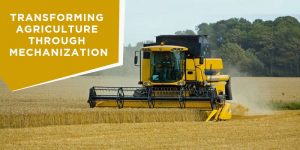Future Trends in Tractor Engines for Farming
India, an agricultural powerhouse, relies heavily on mechanization for efficient farming. Among the various machines aiding farmers, tractors stand out as a pivotal innovation. A tractor’s performance largely depends on its engine—the powerhouse that determines its efficiency, power, and adaptability to different terrains and tasks. This blog provides an in-depth exploration of tractor engines, their history, current advancements, future trends, and how platforms like KhetiGaadi are helping farmers make informed choices. We also discuss government schemes and share success stories to underline the significance of choosing the right tractor engine.
History of Tractor Engines in India
The history of tractor engines in India is intertwined with the evolution of agriculture. Before tractors became commonplace, bullocks and manual labour were the primary means of farming. The introduction of tractors in the 1940s revolutionized agriculture, bringing power and efficiency to fields.
The Early Days:
Initially, tractors were imported from countries like the USA and the UK.
These early models were powered by single-cylinder diesel engines with limited horsepower (HP), catering to small-scale farming.
Domestic Production:
In the 1960s, India began domestic manufacturing with companies like Mahindra & Mahindra and Escorts producing tractors suited to Indian soil and climate.
Early engines were basic, air-cooled diesel variants, providing reliability but limited fuel efficiency.
Key Milestones:
The 1980s marked the introduction of direct injection diesel engines, enhancing fuel efficiency and power delivery.
Turbocharging in the late 1990s revolutionized engine performance, enabling tractors to handle heavy-duty tasks.
Over time, tractor engines evolved to incorporate advanced technologies, meeting the demands of diverse agricultural landscapes and regulatory standards.
Current Technology in Tractor Engines
Modern tractor engines are designed to deliver performance, efficiency, and environmental compliance. Here’s a closer look at the current technologies dominating the Indian market:
1. Multi-cylinder Diesel Engines
- Range: 2 to 6 cylinders
- Power: Multi-cylinder engines deliver higher torque and are versatile for tasks like tilling, sowing, and transportation.
- Popular Brands: Mahindra, Sonalika
2. Turbocharged Engines
These engines use a turbine to increase air intake, improving combustion and fuel efficiency.
- Benefits: High torque at low RPM, ideal for hilly terrains and heavy loads.
- Examples: Swaraj 744 XM, John Deere 5310
3. CRDI (Common Rail Direct Injection) Engines
- Technology: Injects fuel at high pressure, ensuring complete combustion.
- Benefits: Better mileage, reduced emissions, and higher power output.
- Compliance: Meets Bharat Stage IV emission norms.
4. Hybrid Engines
- Combines electric and diesel power for optimal efficiency.
- Advantage: Lower fuel consumption and emissions, suitable for eco-conscious farming.
5. Biofuel-Compatible Engines
- Designed to run on biofuels like ethanol and biodiesel, promoting sustainable farming.
- Government Push: Aligned with India’s National Bio-Energy Mission.
6. Hydraulic-Integrated Engines
- Feature: Integration with advanced hydraulic systems for precision farming.
- Usage: Essential for tasks like planting and spraying.
Upcoming Technology in Tractor Engines
The future of tractor engines is geared toward sustainability, automation, and enhanced efficiency. Let’s explore the advancements that will shape the next generation of tractor engines:
1. Electric Tractor Engines
- Trend: Electric tractors powered by lithium-ion batteries are gaining traction.
- Benefits: Zero emissions, minimal noise, and low maintenance.
- Indian Context: Brands like Sonalika have launched electric tractors such as the Tiger Electric.
2. Hydrogen-Powered Engines
- Promise: Hydrogen engines use hydrogen as fuel, producing water as the byproduct.
- Global Outlook: Currently under research, these engines align with India’s Green Hydrogen Mission.
3. AI-Powered Engines
- Integration: AI systems monitor engine performance, predict maintenance needs, and optimize fuel usage.
- Example: Autonomous tractors with AI-driven engines for precision farming.
4. Variable Speed Engines
- Technology: Adjusts speed and power dynamically based on workload, saving energy.
- Benefits: Increases lifespan and reduces operational costs.
5. Advanced Emission Control Technologies
- Compliance: Future engines will use advanced emission control systems like Selective Catalytic Reduction (SCR) to meet global standards.
KhetiGaadi – Helping Farmers Choose the Right Tractor Engine
KhetiGaadi is revolutionizing the way Indian farmers select tractor engines by providing tailored advice, educational resources, and expert consultations.
Here’s how:
- Customized Recommendations: KhetiGaadi analyzes factors like landholding size, soil type, crop variety, and farmer budget to suggest the most suitable tractor engine.
- Comparative Analysis: The platform offers detailed comparisons of tractor engines, including power output, fuel efficiency, and price points.
- Farmer Education: Through blogs, videos, and workshops, KhetiGaadi explains complex technologies like turbochargers, CRDI, and hybrid engines in simple terms.
- Expert Assistance: Farmers can interact with agricultural experts to address specific queries and make informed decisions.
By bridging the knowledge gap, KhetiGaadi ensures that every farmer invests in the right engine, maximizing productivity and profitability.
Leading Tractor Companies and Their Engine Specifications
| Brand | Engine Type | Power Range (HP) | Price Range (₹) |
| Mahindra | Multi-cylinder Diesel | 15–75 HP | 2.50–12.50 Lakhs |
| Swaraj | Turbocharged Diesel | 20–65 HP | 3.00–10.00 Lakhs |
| John Deere | CRDI Diesel | 35–120 HP | 5.50–25.00 Lakhs |
| Sonalika | Biofuel-Compatible | 20–90 HP | 3.50–15.00 Lakhs |
| Escorts | Hybrid Diesel | 25–75 HP | 4.00–13.00 Lakhs |
| Powertrac | Hydraulic-Integrated Diesel | 30–75 HP | 3.50–11.00 Lakhs |
Government Schemes Supporting Tractor Purchases
1. Sub-Mission on Agricultural Mechanization (SMAM):
Provides subsidies up to 50% on tractors and agricultural machinery.
2. PM Kisan Samman Nidhi Yojana:
Direct financial assistance to farmers, which can be utilized for purchasing tractors.
3. National Green Energy Mission:
Incentivizes biofuel and electric tractor adoption with financial support.
4. State-Level Schemes:
States like Maharashtra and Tamil Nadu offer subsidies for purchasing eco-friendly and advanced tractors.
5. Custom Hiring Centres (CHCs):
Tractors and equipment available for rent at subsidized rates, reducing upfront investment for farmers.
Success Stories of Farmers Choosing the Right Tractor Engines
1) Rajesh Patel, Soybean Farmer in Madhya Pradesh
Rajesh, cultivating 15 acres, faced fuel inefficiency with his old tractor. With guidance from KhetiGaadi, he opted for a turbocharged diesel engine model. The result? A 25% increase in fuel efficiency and 30% higher crop yield, enabling Rajesh to invest in better irrigation systems.
2) Saraswati Devi, Paddy Farmer in Bihar
Saraswati, a small-scale farmer, switched to a biofuel-compatible tractor through the SMAM subsidy scheme. The transition not only reduced her diesel expenses by ₹60,000 annually but also aligned her practices with sustainable farming principles.
Conclusion
Tractor engines form the backbone of modern farming in India. The evolution from single-cylinder engines to AI-driven systems showcases the industry’s commitment to efficiency and sustainability. Platforms like KhetiGaadi and government initiatives ensure that farmers can access the right technology to enhance productivity.
Choosing the right tractor engine is no longer a challenge, thanks to the availability of educational resources, expert guidance, and financial support. Empowered by knowledge and the right tools, Indian farmers are driving agricultural innovation and securing a prosperous future.
Reference Links
SEO Tags:




